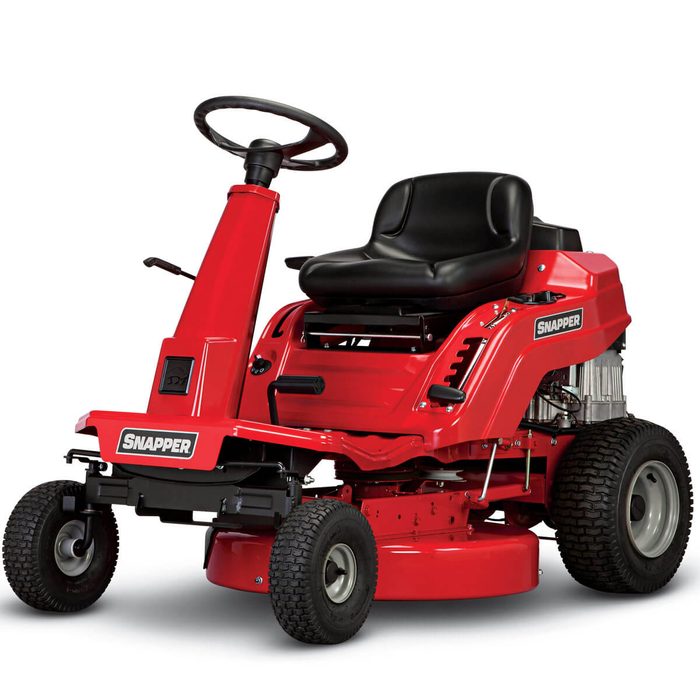Is it Time to Upgrade to a Riding Lawn Mower?

A riding lawn mower is a major time saver, but also a significant investment! Learn about riding mower tech, features and options in this overview.
If you’re in charge of maintaining a lawn that’s a half-acre or more, chances are you’ll appreciate the speed and convenience of a riding lawnmower. Whether you’re buying your first rider or upgrading to a newer model, check out this overview for a snapshot of today’s technology in riding lawn mowers.
On This Page
What Is a Riding Lawn Mower?
Much as the name implies, a riding lawnmower is controlled by an operator who rides on top of the mower as the blades whirl in the cutting deck below. Riding lawn mowers come in many sizes and styles, which makes it easier to find the best fit for your budget and specific needs.
Types of Riding Lawn Mowers
Lawn Tractors
The classic front-engine riding lawn mower that most people are familiar with is more correctly called a “lawn tractor.” Its controls are similar to an automobile, with a steering wheel and a brake. It can also take on various mid-range accessories that aren’t a burden on the engine, like baggers, lawn sweepers and dethatchers. Follow these lawn tractor maintenance tips to keep it humming along smoothly.
Rear-Engine Rider
A rear-engine rider is a dedicated lawn-cutting machine. Lighter and more agile than a lawn tractor, it still uses a traditional wheel steering system.
Zero Turn Mower
By contrast, a zero-turn mower uses a pair of levers to control speed, braking and direction. These “lap bars” may seem intimidating, but for most users the controls quickly become second nature.
Garden Tractor
The final category is the garden tractor. These are a step up from a traditional lawn tractor, capable of tackling heavy chores such as tilling, towing and snow plowing. Although they can certainly mow lawns, garden tractors are intended for much more robust use, and their price reflects that.
Top Riding LawnMower Brands
Most riding lawn mowers are made by well-known lawn mower brands such as John Deere, Cub Cadet, Troy Built, Ryobi and Husqvarna.
Riding Lawn Mower Features
When choosing a riding lawn mower, look for one that accepts accessories and attachments such as baggers, aerators, mulchers and lawn sweepers. Baggers are probably the most frequently used attachment, allowing you to efficiently clear grass clippings and waste material from your lawn.
Most other riding lawn mower features boil down to questions of ruggedness, power and maneuverability. It’s easy to dive into a comparison of horsepower, speed and other specifications, but don’t overlook simple features such as comfort. A high-backed seat that absorbs the bumps and vibrations of the work will help you avoid a sore back.
Riding Mower Buying Considerations and Costs
The biggest factors in selecting a mower are the size of your lawn and your budget. The larger and more rugged your yard, the more robust of a mower you’ll need. Find the sweet spot by looking at the individual mower’s specs. A good rule of thumb: Rugged, uneven terrain demands a garden tractor, followed by lawn tractors and rear mount mowers. Zero-turns are ideal for large flat spaces where their time-saving speed and turn radius can really shine.
Expect to spend about $1,500 to $2,000 for a new lawn tractor. Rear-engine riders are less expensive, coming in about $1,200 to $1,900, while a zero-turn mower will likely run $3,000. If you opt for accessories and add-ons, expect to pay another $500 or so. Refurbished or used models can be found at significant discounts. Those price ranges are for gas-fueled mowers; battery-powered riding mowers usually carry about a 30 percent premium.
If you do opt for a pricier model, remember that financing is often available and seasonal sales can mean deep savings!
Riding Mower Maintenance and Repair Considerations
Although made for hard work, riding mowers are complex machines. They need regular engine service and the occasional repair to other moving parts such as deck lowering mechanisms. Complicating matters, it can be difficult to bring a riding mower to a repair shop, so you may need to find a pro who can pick up and return the mower after repairs are completed.
Luckily, many manufacturers understand their customers take a DIY approach, and many riding mowers have easily-accessible parts so you can make many basic repairs yourself.



